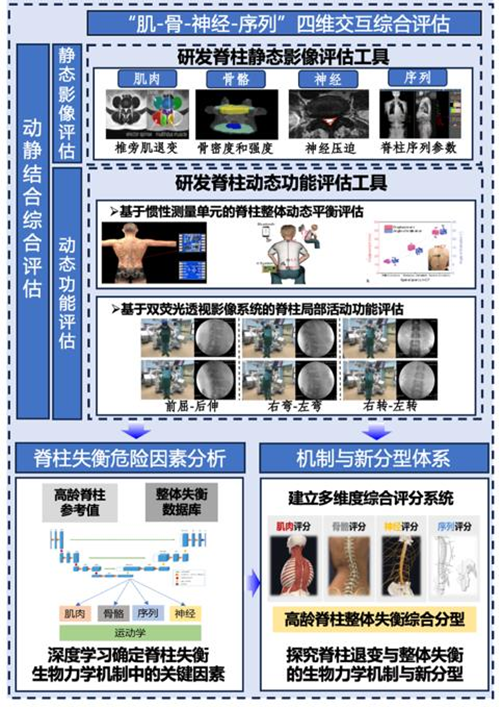
导师队伍
周非非
邮箱:zhoufeifei@bjmu.edu.cn
地址:北京市海淀区学院路38号
个人简介:
周非非,北京大学第三医院骨科副主任,主任医师,教授,博士研究生导师。2024年荣获国家卫健委首届“国家优秀青年医师”;目前担任AOSpine首席骨科教育官、中国康复医学会颈椎病专业委员会副主任委员、Spine Research杂志执行主编;曾获北京市青年教学名师、北京大学杰出青年医师、北京大学世纪金源“腾云青年科学家”等多项荣誉;承担国家重点研发计划在内的多项国家级课题,累计科研转化已超千万元。
主要研究方向:
1. 退行性颈脊髓病病因机制解析与精准防控体系构建
代表成果:首次提出“退行性颈脊髓-脑共患性疾病”概念,借助神经影像学、临床评估等多模态手段,建立标准化诊断流程。依托国家自然科学基金,建立精准慢性颈髓压迫动物模型,首次证实轴突退变在疾病进展中的核心作用。该成果为疾病早期干预和精准防控奠定了理论和技术基础。

图1: 大鼠颈椎脊髓压迫模型示意图
2. 国人颈椎退行性疾病综合评估标准的建立与智能预测模型研发
代表成果:构建以“肌-骨-神经-序列”为核心的四维评估体系,融合AI与动态捕捉技术,率先提出“动态融合指标”替代传统静态CT标准,发表于脊柱外科顶级期刊Spine。基于大样本人群数据建立智能预测模型,实现术后疗效和新发颈痛的精准预测,推动评估维度从结构静态走向功能动态,提升诊疗个性化水平。

图2:构建高龄脊柱患者“肌-骨-神经-序列”四维综合评估工具
3. 微创脊柱手术技术推广与新型内植物研发
代表成果:团队开发具有自主知识产权的“3D打印自稳型零切迹人工椎体”,获得国家医疗器械注册证,并在全国70家医院广泛应用。首次报告“功能保留型”颈后路微创术式,术后康复时间显著缩短,颈椎生理前凸提升32%,轴性疼痛发生率明显下降,研究发表于脊柱外科顶级杂志。该系列成果推动了手术精准化与微创化发展。

图3: 四种改良颈椎后路椎板成形术的手术示意图(A)开门式椎板成形术(B)保留单侧肌肉韧带复合体椎板成形术(C)双开门椎板成形术(D)保留双侧肌肉韧带复合体肌间隙“升顶式”椎板成形术。
代表性科研项目:
1 高龄脊柱退行性病变的防控及诊治技术研究 国家重点研发计划项目2023-2026 主持
2 海马和前额叶皮层调控颈椎术后颈部疼痛慢性化转归的机制研究
国家自然科学基金面上项目2019-2022 主持
3 SARM1介导的神经轴突退变在退变性颈脊髓病中的病理意义和关键机制研究 国家自然科学基金面上项目2023-2026 主持
4 个性化颈椎椎体制备及其生物力学性能研究 北京市自然科学基金 2024-2026 主持
5 颈椎主客观融合型自评量表结合运动功能测评在颈椎病分级诊疗中的应用 首都卫生发展科研专项2020-2022 主持
10篇代表性论文:
1. Chen R, Shi J, Zhao T, et al. Swelling Induced Hardening and Degradation Induced Slow-Expansion Hydrogel for a Modified Cervical Spinal Cord Compression Animal Model. ACS Appl Mater Interfaces. 2024;16(43):58274-58285. doi:10.1021/acsami.4c12023
2. Li X, Wu H, Xu L, et al. Clinical and Radiological Outcomes of Intermuscular “Raising Roof” Modified Cervical Laminoplasty for Cervical Spondylotic Myelopathy: A Retrospective Study of at Least 2 Years Follow-Up. Global Spine J. Published online April 1, 2025:21925682251333285. doi:10.1177/21925682251333285
3. Qu R, Jin J, Wang X, et al. The incidence, clinical features, and risk factors for postoperative retropharyngeal hematoma and related dyspnea following anterior cervical discectomy and fusion: a single-center study of 10,615 patients. Spine J. 2024;24(12):2264-2272. doi:10.1016/j.spinee.2024.08.004
4. Ruomu Q, Siyuan Q, Ben W, et al. Risk of ossification of posterior longitudinal ligament (OPLL) volume progression following laminoplasty. Spine J. Published online May 10, 2025:S1529-9430(25)00256-6. doi:10.1016/j.spinee.2025.05.028
5. Wang B, Qu R, Liu Z, et al. Comparison of Postoperative Pain and Surgical Outcomes Between Three Types of Modified Muscle-Sparing Laminoplasty and Conventional Laminoplasty for Multilevel Degenerative Cervical Myelopathy. Global Spine J. 2025;15(3):1801-1812. doi:10.1177/21925682241265625
6. Wang H, Xia T, Qu R, et al. Interspinous Motion Measurement Could Serve as a Quantitative Method for Assessing Bony Fusion After Anterior Cervical Corpectomy and Fusion. Spine (Phila Pa 1976). 2025;50(3): E39-E45. doi:10.1097/BRS.0000000000005101
7. Zhou F, Ju KL, Zhao Y, et al. Progressive Bone Formation After Cervical Disc Replacement: Minimum of 5-Year Follow-up. Spine (Phila Pa1976).2018;43(3):E163-E170. doi:10.1097/BRS.0000000000002264
8. Zhou F, Li S, Zhang Y, et al. Japanese Orthopaedic Association Cervical Myelopathy Evaluation Questionnaire (JOACMEQ) in mainland China: an investigation of reliability, validity, and responsiveness. Health Qual Life Outcomes. 2020;18(1):349. doi:10.1186/s12955-020-01602-x
9. Zhou F, Li S, Zhao Y, et al. Quantitative analysis of the correlation between preoperative cervical degeneration and postoperative heterotopic ossification after cervical disc replacement: minimum 10-year follow-up data. J Neurosurg Spine. 2020;33(5):674-679. doi:10.3171/2020.4. SPINE 191303
10. Zhou F, Zhang Y, Sun Y, Zhang F, Pan S, Liu Z. Assessment of the minimum clinically important difference in neurological function and quality of life after surgery in cervical spondylotic myelopathy patients: a prospective cohort study. Eur Spine J. 2015;24(12):2918-2923. doi:10.1007/s00586-015-4208-3
